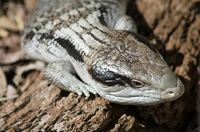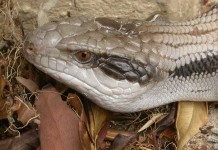Blue tongue skink lizards or Tiliqua are special specie of reptiles that has the most prominent blue colored tongued used mostly to smell or to warn the approaching creature. Although harmless in nature, blue tongue skinks are generally shy of human beings but they can still form excellent house pets as they are one of the few reptile species that can recognize faces and remember voices.
For this purpose, they are kept as pets by many people. Usually found in dry or semi humid places of Asia and Australia, this reptile can be easily tamed and once it gets used to its environment, it can even sit with you and watch television. While buying blue-tongued skink lizard as a pet, it is very important to check for its physical fitness and gender so as to ensure that the reptile is not caught from a barren land.
 Although there are no apparent differences between a male and a female blue tongue skink lizard, yet you may be able to differentiate between the two at a closer look. During breeding season, male lizard tends to get more aggressive towards the female and may even cause injury to her. Therefore, it is important to keep a check on your lizard once you put them together for mating.
Although there are no apparent differences between a male and a female blue tongue skink lizard, yet you may be able to differentiate between the two at a closer look. During breeding season, male lizard tends to get more aggressive towards the female and may even cause injury to her. Therefore, it is important to keep a check on your lizard once you put them together for mating.
Buying a blue tongue skink lizard is a great option for you especially if you do not like high maintenance pets that require constant attention and care. But this does not mean that you can completely neglect you lizard, having a pet is a big responsibility that you need to realize before entering the pet shop.
Characteristics of Blue Tongue Skink Lizards
Identifying the basic characteristics of the lizard, and discuss about their personality and how they behave in normal conditions.
Is a Blue-Tongued Skink Right for You?
Find out if the lizard is suitable for you as your reptile pet; considering factors essential for their healthy living.
What to consider when buying a Skink as pet?
The most important factors to consider when buying this reptile as pet.
Distinguishing Traits of Male and Female Skink
Methods to identify the gender of this lizard.














